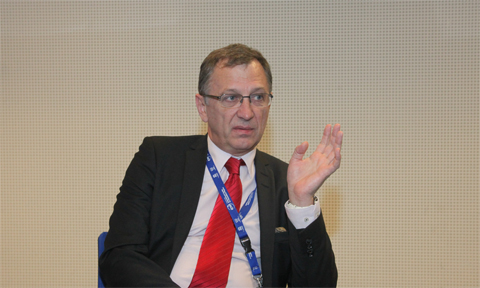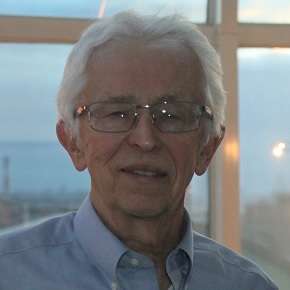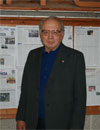 |
||
|
Vladimir Kriventsev: we know ability of fast reactors AtomInfo.Ru, PUBLISHED 28.05.2018 Vladimir Kriventsev, leader of the Fast Reactor Technology Development team in the IAEA's Department of Nuclear Energy, answers questions from correspondents for the electronic publication AtomInfo.Ru. CONTINUED BELOW Vladimir Kriventsev, (c) AtomInfo.Ru  FR17 conference We are still reminding the FR17 conference on fast reactors and related fuel cycles. We believe it was a brilliant conference. It is time now to discuss the main results of the FR17 conference. The FR17 conference may have been the most important conference on fast reactors and related fuel cycles ever held. As I know all the participants appreciated the preparation made. The Agency and Rosatom did very good work in organizing this event. For me it was the first big conference I organized together with my colleague, Ms. Amparo Gonzalez, from start to finish. In the end, what came of it? It was about 600 participants from around the world and we received about 450 technical papers presented on different topics related to fast reactor development in the future. We also had 11 keynote speeches delivered by the countries that are doing research on fast reactors and by four international organizations. These are some of the key numbers. But as IAEA Deputy Director General Mikhail Chudakov said, fast reactor technology can be seen as a bridge to the future. We know that nuclear energy systems that utilize fast reactors in a closed fuel cycle could provide sustainable energy for many generations. Of course, some countries may prefer other energy sources, such as wind, solar or hydro energy. It is their choice, but we are aware of the future potential of fast reactors and closed fuel cycles. What topics and scientific results of the FR17 were the most interesting for you personally as the nuclear engineer? As the scientific secretary I was so busy that I could not participate in some sections which I wanted to attend. Actually, the organizing committee members had even no time for lunch. As a moderator I took part in the panel discussion on the safety design guidelines and the safety design criteria for sodium-cooled fast reactors and their relation to the Generation-IV safety criteria developed by the Generation-IV International Forum (GIF). The discussion was very interesting and useful. This is a very important issue because GIF formulated its goals and objectives for the safety of future reactors. You mention the GIF forum and we know the IAEA role in the project but do you have any cooperation with the OECD projects in the nuclear field? Certainly yes, and the OECD/NEA presented the keynote speech at the FR17 conference. We have good relations with the OECD and with the European Commission Joint Research Center (EC/JRC) -- they are actively participating in our events and projects. Events and projects The FR17 conference is finished but the work is continuing. What are the next Agency's big events or projects in the field of the fast reactors? The FR17 is not completed yet; we still must publish the conference proceedings. Yes, sure. Anyway, we know you are working with the ICTP in Trieste for different events. We have good cooperation with the Abdus Salam International Centre for Theoretical Physics (ICTP). Together we organize on a regular basis workshops, nuclear schools and other events. We invite famous and skilled experts in the field who are able to deliver talks on state-of-the-art technology and its history. Also, the students are actually young scientists and engineers and we usually require that they make a poster presentation. The next joint ICTP-IAEA workshop on Physics and Technology of Innovative Nuclear Energy Systems is planned for the end of August 2018. We know that the IAEA Nuclear Energy Department manages the coordinated research projects devoted to the innovative reactor technology. Yes. One such project, the benchmark analysis of EBR-II shutdown heat removal tests, was finished in 2017. The final document was prepared in our department and published; you may find it freely available on the Agency's website. The next coordinated research project, which is going on right now, is the NAPRO CRP - "Sodium Properties and Safe Operation of Experimental Facilities in Support of the Development and Deployment of Sodium-cooled Fast Reactors". The main idea of the NAPRO CRP is to collect and assess all available data on the physical and chemical properties of sodium coolant. The results will be published as IAEA TECDOCs. The first NAPRO Handbook will be a collection the physical and chemical properties of sodium coolant. Another will be devoted to thermal hydraulic data, such as heat transfer coefficients, friction factors, and others. It should be a hard work. How long are you working on this project? Actually, the duration of the NAPRO project will be five years. It was started in 2013 and it shall be completed in 2018. The NAPRO CRP attracted a lot of participants. And here I would like to thank Argonne National Laboratory, which is a very good contributor. I have to mention also the important contribution of the Obninsk IPPE for the part of the project concerning the thermalhydraulic data. There is a difference between the NAPRO and other coordinated research projects, which have been done in several countries and international organizations. We not only collect sodium coolant properties, we assess and compare the data. Will the results of the NAPRO projects be available for all countries? Yes, for sure. When published, the NAPRO TECDOCs will be freely available as are all other Agency's publications. Another CRP, which could be interesting for you, is the project for studying the radioactive release from the prototype fast breeder reactor under severe accident conditions. It was initiated by our Indian colleagues and it is a valuable benchmark for the several safety analysis computer codes. I would also like to mention one more coordinated research project, which would deal with the neutronics start-up of the Chinese CEFR fast reactor. Another CRP will be a benchmarking of the safety analysis codes versus the unprotected loss of flow (ULOF) tests conducted at the sodium-cooled fast reactor called Fast Flux Test Facility in the USA. Other news: 443 nuclear units are operating in the world Another 65 units have the status of the being built one. New American submarine will be named after admiral Rickover 60th anniversary of the first trip of the nuclear submarine Nautilus. Westinghouse will deliver CE16NGF fuel on Palo Verde This is a new generation fuel for 16×16 grid. |
Hero of the day 
Siegfried Hecker: we are doomed to cooperate When I look at the past, I've always thought that cooperation was extremely important.My feeling is that we did a lot of good; there were a lot of benefits to both countries. It's often not appreciated that it was actually beneficial to both countries. Itis unfortunate that it came pretty much to an end between U.S. and Russia. INTERVIEW
William D. Magwood IV OPINION
Rudolf Baklushin |

